
How to Stop Negative Thoughts?
Negative thoughts are those persistent, unhelpful ideas that bring doubt, fear, or self-criticism into our minds. They often pop up unexpectedly, shaping how we see ourselves and the world.
While everyone experiences negative thoughts occasionally, when they become frequent or overpowering, they can have a serious impact on mental health and well-being.
These thoughts can fuel anxiety, lowering self-esteem, and even contribute to depression.
For example, replaying a mistake or constantly worrying about the future can drain your energy and prevent you from enjoying the present.
Over time, negative thinking can affect relationships, disrupt personal growth, and make everyday challenges feel overwhelming.
The good news is that you don’t have to stay stuck in a cycle of negativity. Stopping negative thoughts is a decisive step toward regaining control of your mental state.
By shifting your mindset and adopting practical strategies, you can reduce their hold and create space for more balanced and positive thinking.
This blog will explore the causes and effects of negative thoughts and share actionable tips to help you break free from their grip.
Whether through mindfulness, cognitive exercises, or lifestyle changes, you’ll discover tools to foster a healthier, more constructive mindset.
Why Do I Have Negative Thoughts?
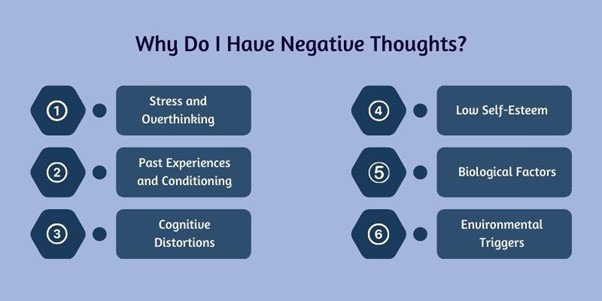
Negative thoughts can arise from psychological, biological, and environmental factors. They often stem from processing information, responding to stress, and interpreting our experiences.
Understanding the root causes of negative thinking can help you take steps to address and manage them more effectively.
1. Stress and Overthinking
Stressful situations can trigger a cascade of negative thoughts. When under pressure, the brain focuses on worst-case scenarios as a defense mechanism.
Overthinking magnifies this effect, making minor problems feel overwhelming and keeping the mind in a loop of unhelpful thinking.
2. Past Experiences and Conditioning
Negative thoughts are often shaped by past experiences, especially during childhood. Critical comments, failures, or traumatic events may create lasting patterns of self-doubt or fear.
These thought patterns can become automatic, influencing how we view current situations.
3. Cognitive Distortions
Common cognitive distortions, such as black-and-white thinking, catastrophizing, or jumping to conclusions, often fuel negative thoughts.
These distortions distort reality, leading us to focus on flaws, mistakes, or unlikely outcomes while ignoring positive aspects.
4. Low Self-Esteem
People with low self-esteem often internalize negative beliefs about themselves. This can lead to frequent self-criticism and a tendency to expect failure or rejection.
5. Biological Factors
Brain chemistry also contributes to negative thinking. Imbalances in neurotransmitters like serotonin or dopamine can make it harder to maintain a positive outlook, contributing to cycles of negativity.
6. Environmental Triggers
Your surroundings can significantly impact your mindset. Toxic relationships, a high-stress job, or constant exposure to negativity through media or social platforms can reinforce unhelpful thought patterns.
By recognizing these causes, you can start identifying triggers and adopting strategies to overcome negative thoughts and promote healthier thinking.
How to Recognize and Label Negative Thoughts
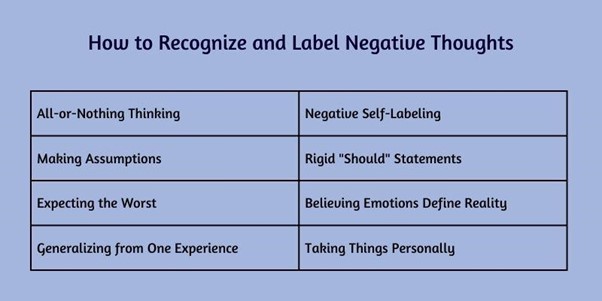
Recognizing and labeling negative thoughts is a critical first step in breaking their hold on your mind.
Negative thoughts often appear as automatic reactions, making them difficult to notice initially. However, by increasing self-awareness, you can identify and address these unhelpful patterns.
Recognizing negative thoughts involves observing your internal dialogue, especially in stressful or emotionally charged situations.
Labeling them means giving them names such as “all-or-nothing thinking” or “catastrophizing” to help separate them from reality.
Once labeled, it becomes easier to challenge and replace these thoughts with healthier perspectives.
1. All-or-Nothing Thinking
This form of negative thought involves viewing situations in black-and-white terms without acknowledging the shades of gray in between.
For example, you might think, “If I don’t excel at this project, I’m a total failure.” This thinking ignores the effort, partial successes, or lessons learned.
To recognize this pattern, look for words like “always,” “never,” or “completely” in your thoughts. Labeling it as “all-or-nothing thinking” helps you step back and evaluate whether your conclusions are overly rigid or exaggerated.
Replacing this thought with a balanced perspective, such as “I may not have done perfectly, but I made progress,” can be more constructive.
2. Making Assumptions
This occurs when you jump to conclusions about someone’s thoughts or intentions without evidence.
For example, if a friend doesn’t reply to your message right away, you might think, “They must be mad at me.” These assumptions often stem from insecurities or fear of rejection.
Recognizing this pattern requires questioning your initial conclusions.
Label it as “mind-reading” or “assuming the worst,” and ask yourself, “Do I have proof of this?” Often, the answer will be no. Gathering facts instead of assuming can help you avoid unnecessary worry.
3. Expecting the Worst
This involves assuming the most catastrophic outcome, even when the chance is low.
For example, you might think, “If I make a mistake during this presentation, my boss will fire me.” This pattern magnifies minor setbacks into major disasters.
To identify this pattern, notice if your thoughts include worst-case scenarios. Labeling it as “catastrophizing” allows you to question the realism of your fears.
Instead, focus on preparing for challenges while acknowledging that most outcomes are less dire than your mind predicts.
Recognizing and labeling these patterns gives you the clarity to challenge and change them. This practice can significantly improve your mental well-being and resilience.
4. Generalizing from One Experience
This pattern occurs when a single negative experience is used to predict similar outcomes in the future.
For example, if you failed an exam, you might think, “I’ll never do well in any subject.” This thinking ignores the possibility of growth, learning, and improvement.
Labeling it as “overgeneralization” can help you realize that one event doesn’t define the future. Instead, remind yourself that mistakes or setbacks are specific to a moment and can be overcome with effort.
Reframing the thought, “I struggled this time, but I can prepare better next time,” helps build resilience and maintain perspective.
5. Negative Self-Labeling
This pattern involves assigning harsh or critical labels to yourself or others, such as “I’m a failure” or “He’s so lazy.”
These labels oversimplify complex individuals and situations, often leading to shame, frustration, or resentment.
Recognize when you use absolute terms to define yourself or others to counter this. Label it as “negative self-labeling” and ask, “Is this label fair or accurate?” More often than not, these labels ignore positive qualities and contributions.
Instead, focus on describing specific actions rather than using global judgments, such as saying, “I made a mistake on this project, but I’ll learn from it.”
6. Rigid “Should” Statements
Thinking in terms of “should,” “must,” or “ought to” sets unrealistic expectations, often leading to guilt, frustration, or a sense of failure when reality doesn’t align.
For example, “I should always be productive” creates unnecessary pressure and ignores the need for rest.
To overcome this, recognize when these rigid statements dominate your thoughts. Label them as “should-thinking” and consider whether they’re fair or realistic.
Replace them with flexible statements like, “It’s okay to take a break; rest is important for productivity.” Shifting from “should” to “could” adds a sense of choice and reduces internal pressure.
7. Believing Emotions Define Reality
This pattern occurs when you assume that how you feel reflects the truth of a situation. For example, feeling anxious may lead you to believe, “Something bad is going to happen.” This thinking often results in unnecessary fear or avoidance.
Recognizing this involves distinguishing between feelings and facts. Label it as “emotional reasoning” and challenge it by asking, “What evidence supports this belief?” Often, your emotions are a response to perception, not reality.
Reframing the thought as, “I feel nervous, but that doesn’t mean I’m in danger,” helps to ground you and reduce anxiety.
8. Taking Things Personally
This occurs when you blame yourself for external events or interpret others’ actions as directed at you. For example, if a coworker is in a bad mood, you might think, “I must have upset them.”
To address this, recognize when you’re personalizing situations without evidence. Label it as “taking things personally” and remind yourself that others’ actions are often unrelated to you.
Instead, focus on what you can control and avoid assumptions about others’ intentions. Shifting your perspective can protect you from unnecessary guilt or frustration.
Reframe Your Thoughts

Reframing your thoughts is a powerful way to shift your perspective and break free from the cycle of negativity.
It involves identifying and replacing distorted thinking patterns with balanced, constructive ones. The goal is not to deny challenges but to approach them with a mindset that fosters growth, resilience, and well-being.
Reframing starts with self-awareness. When you notice a negative thought, pause and analyze it. Is it based on facts, influenced by emotions, or based on assumptions?
This practice helps you regain control over your mental state and empowers you to approach situations clearly and confidently.
1. Challenge Cognitive Distortions
Cognitive distortions, such as all-or-nothing thinking or catastrophizing, often make situations seem worse than they are. To challenge these distortions, question their validity. Ask yourself:
- Do facts support this thought, or is it based on assumptions?
- What would I tell a friend in a similar situation?
For example, instead of thinking, “I always fail at everything,” challenge it with, “I didn’t do well this time, but I’ve succeeded before, and I can try again.”
This process helps you break free from exaggerated, self-critical thoughts and develop a more balanced outlook.
2. Find Alternative Explanations
Negative thoughts often overlook alternative perspectives. If you’re stuck thinking, “My boss is upset with me because I didn’t do well,” consider other possibilities: “Maybe my boss is stressed about something unrelated.”
Look for evidence that contradicts your negative assumptions. Write down alternative explanations to gain a clearer picture.
By broadening your perspective, you create space for understanding and reduce unnecessary guilt or worry. This practice encourages you to see situations as multifaceted rather than black-and-white.
3. Use Positive Affirmations
Positive affirmations involve replacing negative self-talk with empowering statements. Instead of thinking, “I’ll never get through this,” affirm, “I have faced challenges before and overcome them.”
Regularly practicing affirmations can help rewire your brain to focus on strengths rather than perceived weaknesses. To make affirmations more effective, ensure they are specific, realistic, and meaningful to you.
For example, instead of a vague “I am successful,” try, “I am capable of handling challenges and learning from them.”
Affirmations may feel unnatural initially, but repetition can reshape your internal dialogue, boosting self-esteem and fostering resilience.
By consistently affirming your strengths, you build a mental buffer against negative thoughts and cultivate a more positive mindset.
Take Action to Disrupt Negative Thinking
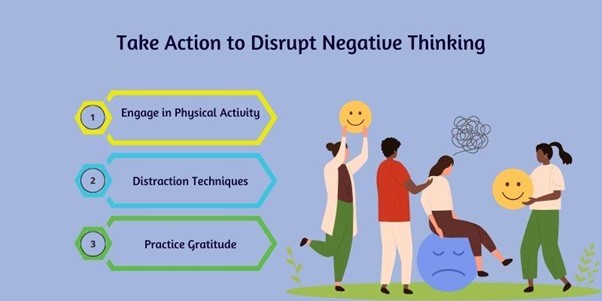
Disrupting negative thinking requires proactive steps to shift focus and reframe your mindset.
While it’s important to recognize and address negative thoughts, sometimes the best way to break their hold is through action.
Engaging in purposeful activities can divert your attention, clear your mind, and create space for more constructive thinking patterns.
Taking action isn’t about avoiding the root of the issue—it’s about interrupting the mental loop of negativity and creating an opportunity for a fresh perspective.
From physical activity to cultivating gratitude, these techniques can help you regain control over your mental state and improve your emotional well-being.
1. Engage in Physical Activity

Physical activity is a proven method for breaking the cycle of negative thoughts. Exercise releases endorphins, the brain’s feel-good chemicals, which improve mood and reduce stress.
Walking, jogging, or yoga can provide a mental reset by shifting your focus to your body and movement.
For instance, a brisk walk in nature distracts you from negative thoughts, helps clear your mind, and reduces the intensity of emotions.
Regular physical activity improves overall resilience, making you less likely to dwell on unproductive thoughts. Moving your body can also feel empowering, giving you a sense of control and accomplishment.
2. Distraction Techniques

Engaging in a distracting activity can provide immediate relief when negative thoughts persist.
Activities like solving puzzles, playing a musical instrument or watching a movie help redirect your focus and interrupt the mental loop of negativity.
Spending time with loved ones is another effective distraction. Conversations and shared experiences can uplift your mood and remind you of the positive aspects of your life.
Even simple hobbies, such as gardening or baking, can offer a sense of accomplishment and joy, shifting your focus away from negative self-talk.
3. Practice Gratitude

Gratitude is a powerful tool for countering negative thoughts. When you focus on what you’re thankful for, you train your brain to notice the positive aspects of your life, even during difficult times.
Start by writing down three things you’re grateful for each day. These can be simple, such as enjoying a good meal, a kind gesture from a friend, or even the weather.
Over time, this practice rewires your brain to seek out the good, making it harder for negative thoughts to dominate.
Practicing gratitude helps put challenges into perspective. It doesn’t dismiss your struggles but reminds you that there are still positive elements in your life. By cultivating an attitude of thankfulness, you cultivate a resilient and optimistic mindset, making it easier to manage negative thinking.
Establish Healthy Thought Habits
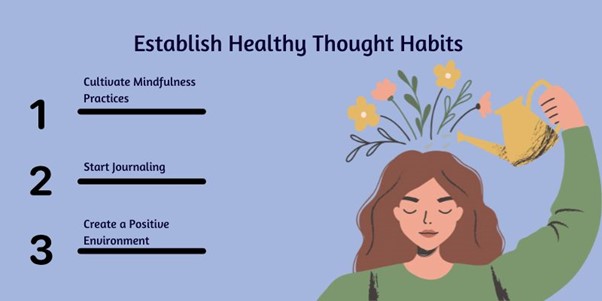
Creating healthy thought habits is essential for long-term mental well-being. Negative thinking patterns can become ingrained over time, making it challenging to maintain a positive outlook.
However, by intentionally building habits that encourage positivity and resilience, you can retrain your brain to focus on constructive and empowering thoughts.
Healthy thought habits are not about ignoring challenges but approaching them from a balanced perspective.
Practices such as mindfulness, journaling, and fostering a supportive environment provide practical tools to reshape your mindset and reduce the frequency and impact of negative thoughts.
1. Cultivate Mindfulness Practices

Mindfulness is a powerful technique for staying present and interrupting negative thought spirals.
Practices like meditation or deep breathing help anchor your focus on the present moment, reducing the tendency to ruminate on the past or worry about the future.
For example, mindfulness meditation involves sitting quietly and observing your thoughts without judgment. When negative thoughts arise, you acknowledge them and let them pass rather than get caught up in their narrative.
This practice trains your brain to detach from unproductive thinking patterns, creating clarity and calm.
Mindfulness can also be integrated into everyday activities, such as mindful eating or walking.
By paying attention to the present moment, you foster self-awareness and develop the ability to identify and redirect negative thought patterns before they escalate.
2. Start Journaling

Journaling is an effective way to process and challenge negative thoughts. Writing down your thoughts allows you to observe them more objectively and identify patterns in your thinking.
Start by dedicating a few minutes each day to jotting down your thoughts, emotions, and experiences. If you notice negative thinking, ask yourself questions like, “Is this thought realistic?” or “What evidence supports this belief?”
Over time, this practice helps you challenge cognitive distortions and replace them with more balanced perspectives.
Gratitude journaling is another beneficial approach. Listing things you’re thankful for shifts your focus from what’s wrong to what’s going well.
This habit improves your mood and strengthens your ability to reframe challenges positively.
3. Create a Positive Environment

Your environment plays a significant role in shaping your thoughts and emotions. Surrounding yourself with positive influences, both physically and mentally, creates a supportive backdrop for healthy thought habits.
Social interactions are key. Spend time with people who uplift and encourage you rather than those who drain your energy.
Positive conversations and relationships can affect one’s outlook. Similarly, reducing exposure to social media—especially accounts or posts that fuel comparison or negativity—can protect one’s mental space.
Physically, decluttering your space or adding elements like plants, natural light, or calming decorations can enhance your sense of well-being.
A clean and organized environment often mirrors and supports a clearer mental state, making it easier to maintain positive habits.
Seek Professional Help if Needed
Sometimes, negative thoughts can become overwhelming and persistent, affecting your daily life, relationships, and overall well-being. When these thoughts interfere with your ability to function, it may be time to seek professional help.
Mental health professionals can provide guidance, tools, and therapeutic approaches tailored to your specific needs, helping you break free from negative thinking patterns and regain control over your mental state.
Cognitive Behavioral Therapy (CBT)
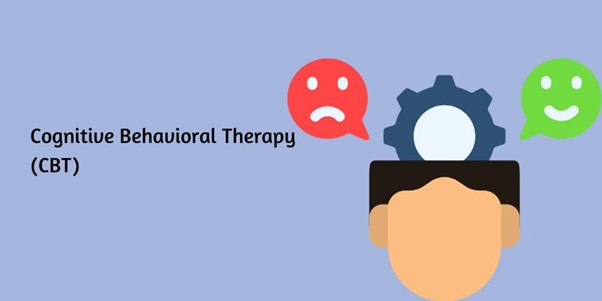
One of the most effective therapies for managing negative thoughts is Cognitive Behavioral Therapy (CBT).
CBT focuses on identifying and changing unhelpful thought patterns and replacing them with more constructive and balanced ways of thinking.
In CBT, a therapist works with you to uncover the root causes of your negative thoughts. For example, they might help you recognize distorted thinking patterns like catastrophizing or personalizing.
Through structured exercises, you learn to challenge these patterns and replace them with more rational and empowering thoughts.
CBT also emphasizes actionable strategies, such as practicing thought reframing, building coping skills, and gradually confronting triggers.
Over time, this approach reduces the frequency of negative thoughts and strengthens your resilience to handle future challenges.
When to Seek Professional Help

Consulting a therapist or counselor can be transformative if negative thoughts persist despite self-help efforts. Signs that professional intervention may be necessary include:
- Difficulty concentrating or performing daily tasks.
- Persistent feelings of hopelessness or sadness.
- Sleep disturbances or changes in appetite.
- Increased anxiety or irritability.
Additionally, if negative thoughts are accompanied by harmful behaviors, self-isolation, or thoughts of self-harm, seeking help immediately is critical.
Mental health professionals can also explore if underlying conditions, such as depression or anxiety, contribute to your negative thought patterns. With their support, you can create a personalized plan for a healthier, more balanced mindset.
Conclusion
Negative thoughts can be overwhelming, shaping how we view ourselves, others, and the world around us. Recognizing and addressing these thought patterns is crucial to regaining control over your mental and emotional well-being.
Understanding the root causes and learning techniques to challenge and reframe negative thinking can create space for a more constructive and balanced perspective.
While breaking free from negative thought patterns may not happen overnight, consistent effort and patience can lead to transformative changes.
Simple practices like mindfulness, journaling, and gratitude exercises help shift your mindset. At the same time, physical activity and social connections offer additional outlets to disrupt negativity.
Seeking professional support, if needed, ensures you have the right tools and guidance to navigate persistent challenges.
Managing negative thoughts is more than just an exercise in positivity—it’s a powerful way to improve mental health, relationships, and overall quality of life.
As you replace negative self-talk with constructive thoughts, you’ll be more equipped to handle life’s stresses and setbacks with clarity and resilience.





Responses